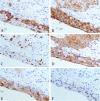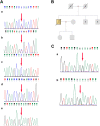Whole-exome sequencing reveals the etiology of the rare primary hepatic mucoepidermoid carcinoma
- PMID: 33832503
- PMCID: PMC8034126
- DOI: 10.1186/s13000-021-01086-3
Whole-exome sequencing reveals the etiology of the rare primary hepatic mucoepidermoid carcinoma
Abstract
Background: Primary hepatic mucoepidermoid carcinoma (HMEC) is extremely rare and the molecular etiology is still unknown. The CRTC1-MAML2 fusion gene was previously detected in a primary HMEC, which is often associated with MEC of salivary gland in the literature.
Methods: A 64-year-old male was diagnosed with HMEC based on malignant squamous cells and mucus-secreting cells in immunohistochemical examination. Fluorescence in situ hybridization (FISH) was used to detect the CRTC1-MAML2 fusion gene in HMEC. Whole-exome sequencing and Sanger sequencing were used to reveal the molecular characteristics of HMEC and analysis was performed with public data. Pedigree investigation was performed to identify susceptibility genes.
Results: Hematoxylin-eosin staining and immunohistochemistry revealed that the tumor cells were composed of malignant epidermoid malignant cells and mucous cells, indicating a diagnosis of HMEC. The CRTC1-MAML2 fusion gene was not detected in the primary HMEC, and somatic mutations in GNAS, KMT2C and ELF3 genes were identified by sequencing. Analyses of public data revealed somatic GNAS alterations in 2.1% hepatobiliary tumors and relation with parasite infection. Heterozygous germline mutations of FANCA, FANCI, FANCJ/BRIP1 and FAN1 genes were also identified. Pedigree investigation verified that mutation of Fanconi's anemia susceptibility genes were present in the pedigree.
Conclusions: Here we provide the first evidence of the molecular etiology of a rare HMEC associated with germline Fanconi's anemia gene mutations and somatic GNAS R201H mutation.
Keywords: Germline Fanconi’s anemia mutation; Hepatic mucoepidermoid carcinoma (HMEC); Somatic GNAS R201 mutation; Whole exome-sequencing (WES).
Conflict of interest statement
The authors declare no conflict of interests. The authors declare no competing financial interest.
Figures






Similar articles
-
Primary hepatobiliary mucoepidermoid carcinoma: a case report and review of literature.Med Mol Morphol. 2024 Sep;57(3):233-243. doi: 10.1007/s00795-024-00390-3. Epub 2024 Jun 21. Med Mol Morphol. 2024. PMID: 38904830 Review.
-
Genomics and tumor microenvironment of breast mucoepidermoid carcinoma based on whole-exome and RNA sequencing.Diagn Pathol. 2024 Jan 19;19(1):15. doi: 10.1186/s13000-024-01439-8. Diagn Pathol. 2024. PMID: 38243319 Free PMC article.
-
"Pancreatic Mucoepidermoid Carcinoma" Is not a Pancreatic Counterpart of CRTC1/3-MAML2 Fusion Gene-related Mucoepidermoid Carcinoma of the Salivary Gland, and May More Appropriately be Termed Pancreatic Adenosquamous Carcinoma With Mucoepidermoid Carcinoma-like Features.Am J Surg Pathol. 2018 Nov;42(11):1419-1428. doi: 10.1097/PAS.0000000000001135. Am J Surg Pathol. 2018. PMID: 30138216
-
Warthin-like Mucoepidermoid Carcinoma: A Combined Study of Fluorescence In Situ Hybridization and Whole-slide Imaging.Am J Surg Pathol. 2015 Nov;39(11):1479-87. doi: 10.1097/PAS.0000000000000507. Am J Surg Pathol. 2015. PMID: 26457352
-
Spindle Cell Mucoepidermoid Carcinoma of the Palatine Tonsil With CRTC1-MAML2 Fusion Transcript: Report of a Rare Case in a 17-Year-Old Boy and a Review of the Literature.Int J Surg Pathol. 2017 Dec;25(8):705-710. doi: 10.1177/1066896917714890. Epub 2017 Jun 21. Int J Surg Pathol. 2017. PMID: 28637362 Review.
Cited by
-
Recent Advances in Pathology of Intrahepatic Cholangiocarcinoma.Cancers (Basel). 2024 Apr 17;16(8):1537. doi: 10.3390/cancers16081537. Cancers (Basel). 2024. PMID: 38672619 Free PMC article. Review.
-
The clinical outcome, pathologic spectrum, and genomic landscape for 454 cases of salivary mucoepidermoid carcinoma.NPJ Precis Oncol. 2024 Oct 22;8(1):238. doi: 10.1038/s41698-024-00735-2. NPJ Precis Oncol. 2024. PMID: 39438706 Free PMC article.
-
Primary mucoepidermoid carcinoma of the intrahepatic bile duct: A case report.Clin Case Rep. 2022 Feb 2;10(2):e05359. doi: 10.1002/ccr3.5359. eCollection 2022 Feb. Clin Case Rep. 2022. PMID: 35140960 Free PMC article.
-
Clinicopathological practice in the differential diagnosis of mucoepidermoid carcinoma from neoplasms with mucinous component.Chronic Dis Transl Med. 2023 Jan 2;9(1):29-38. doi: 10.1002/cdt3.55. eCollection 2023 Mar. Chronic Dis Transl Med. 2023. PMID: 36926257 Free PMC article.
-
Primary hepatobiliary mucoepidermoid carcinoma: a case report and review of literature.Med Mol Morphol. 2024 Sep;57(3):233-243. doi: 10.1007/s00795-024-00390-3. Epub 2024 Jun 21. Med Mol Morphol. 2024. PMID: 38904830 Review.
References
-
- Tonon G, Modi S, Wu L, Kubo A, Coxon AB, Komiya T, O’Neil K, Stover K, el-Naggar A, Griffin JD, Kirsch IR, Kaye FJ. t(11;19)(q21;p13) translocation in mucoepidermoid carcinoma creates a novel fusion product that disrupts a Notch signaling pathway. Nat Genet. 2003;33(2):208–213. doi: 10.1038/ng1083. - DOI - PubMed
-
- Saeki K, Ohishi Y, Matsuda R, Mochidome N, Miyasaka Y, Yamamoto H, Koga Y, Maehara Y, Nakamura M, Oda Y. “Pancreatic mucoepidermoid carcinoma” is not a pancreatic counterpart of CRTC1/3-MAML2 fusion gene-related mucoepidermoid carcinoma of the salivary gland, and may more appropriately be termed pancreatic adenosquamous carcinoma with mucoepidermoid carcinoma-like features. Am J Surg Pathol. 2018;42(11):1419–1428. doi: 10.1097/PAS.0000000000001135. - DOI - PubMed
Publication types
MeSH terms
Substances
Grants and funding
LinkOut - more resources
Full Text Sources
Other Literature Sources
Medical
Research Materials
Miscellaneous

